
The Mausoleum of Emperor Qinshihuang: A Timeless Wonder Welcomes Millions
XI'AN, Sept. 27 (Xinhua) -- The Mausoleum of Qinshihuang, the first emperor of a united China, has received more than 120 million tourists, including 20 million from overseas since a museum was built on the site and opened to the public in 1979.
A Legacy in Stone and Earth
The Mausoleum of Qinshihuang is more than just a tomb; it is a testament to the ambition and power of the first emperor who unified China in 221 BC. Constructed over decades, the mausoleum complex is a vast necropolis filled with treasures and wonders. While the central tomb itself remains unopened, the surrounding pits and excavations reveal a glimpse into the past.
The Terracotta Army: Sentinels of Eternity
The most famous feature of the Mausoleum of Qinshihuang is undoubtedly the Terracotta Army. These life-sized clay soldiers, each with unique features and weaponry, were created to guard the emperor in the afterlife. Discovered in 1974 by local farmers, the Terracotta Army has captivated the world and become a symbol of China's ancient past.
A Museum Unveiling History
Since the opening of the museum in 1979, the site has become a place of pilgrimage for history enthusiasts, curious travelers, and anyone seeking to connect with China's rich cultural heritage. The museum showcases artifacts unearthed from the mausoleum complex, providing context and insights into the Qin dynasty and the life of Emperor Qinshihuang.
A Global Attraction
The fact that over 20 million tourists from overseas have visited the Mausoleum of Qinshihuang speaks to its universal appeal. The site transcends cultural barriers, offering a glimpse into a pivotal period in human history. It is a place where visitors can marvel at the ingenuity of ancient craftsmanship, contemplate the grandeur of empires past, and reflect on the enduring legacy of one of history's most influential figures.
Preservation for Future Generations
The ongoing preservation efforts at the Mausoleum of Qinshihuang are of paramount importance. Archaeologists, conservators, and other experts work tirelessly to protect the site from the elements and the passage of time. Their dedication ensures that this remarkable testament to human history will continue to inspire and awe generations to come.
Q&A
Q: When did the Mausoleum of Qinshihuang open to the public?
A: The museum at the Mausoleum of Qinshihuang opened to the public in 1979.
Q: What is the most famous feature of the mausoleum complex?
A: The most famous feature is the Terracotta Army, a vast collection of life-sized clay soldiers.
Q: How many tourists have visited the Mausoleum of Qinshihuang?
A: Over 120 million tourists, including 20 million from overseas, have visited since the museum's opening.
note: This return of all, without the author's permission, may not be reproduced